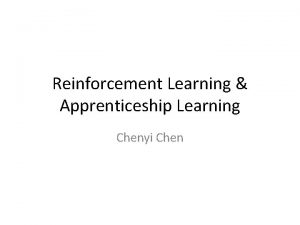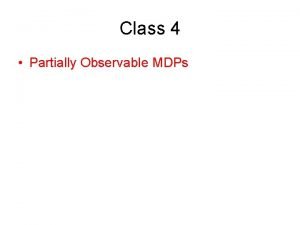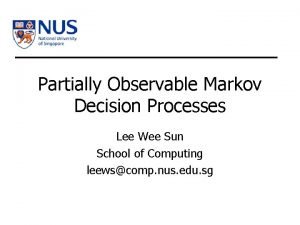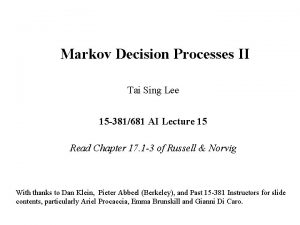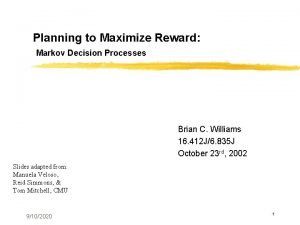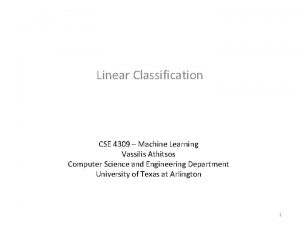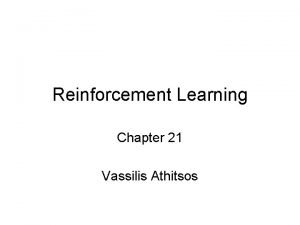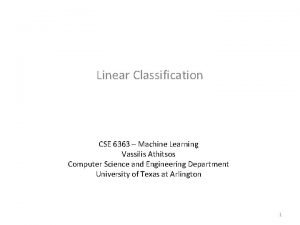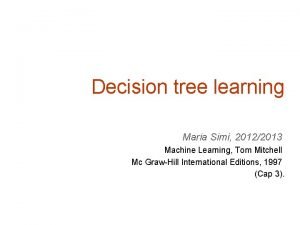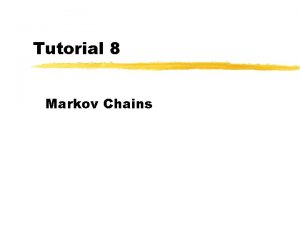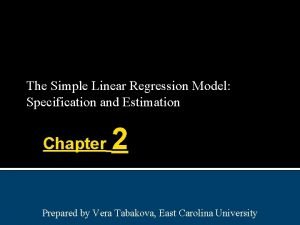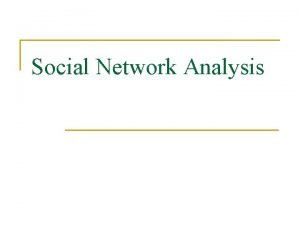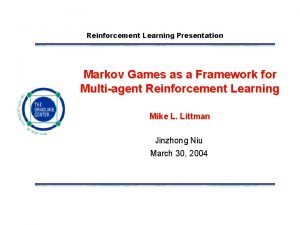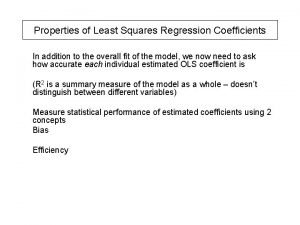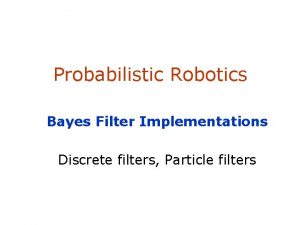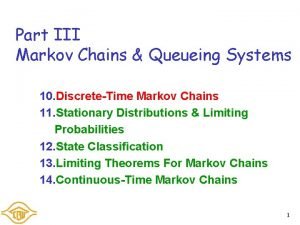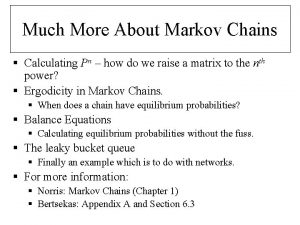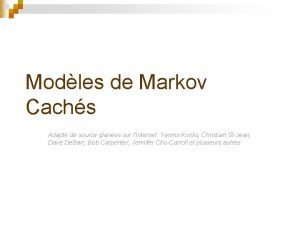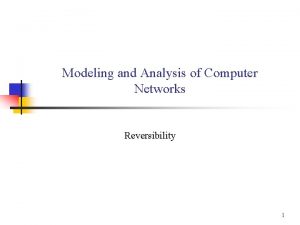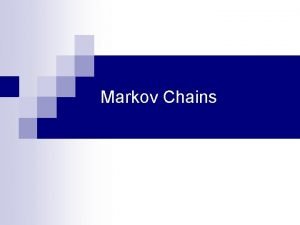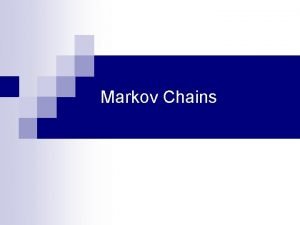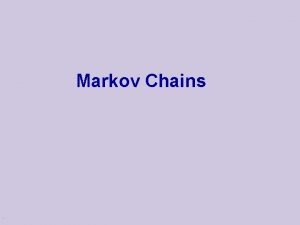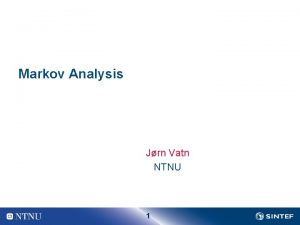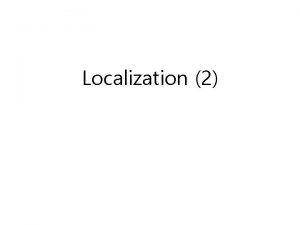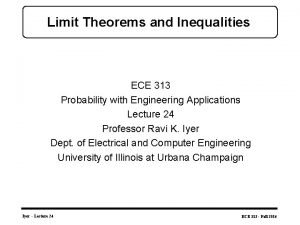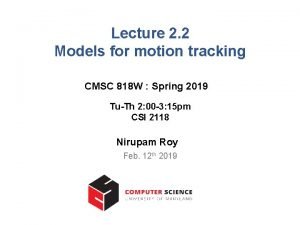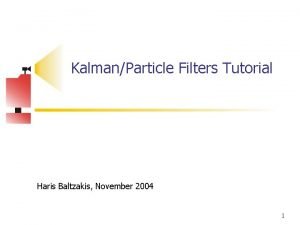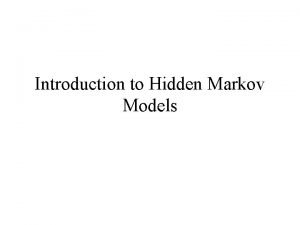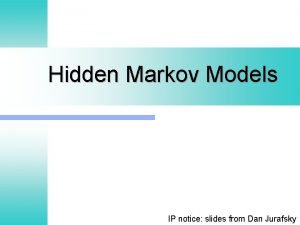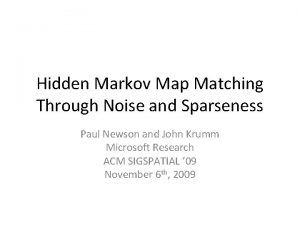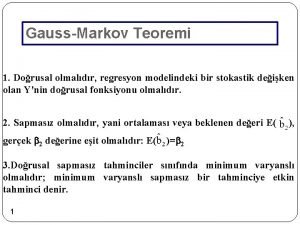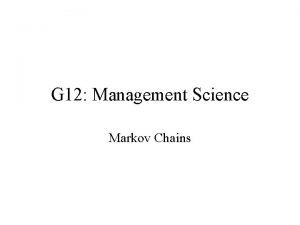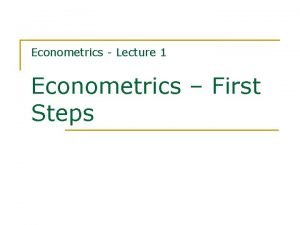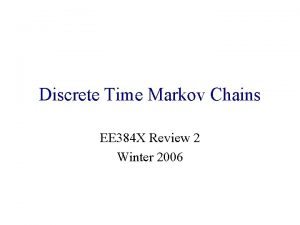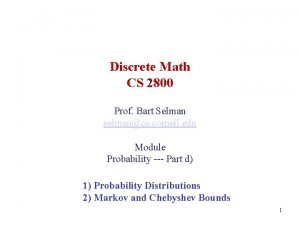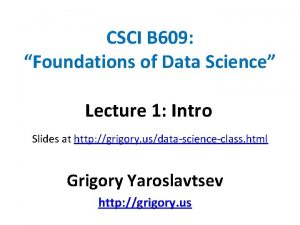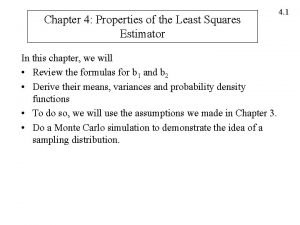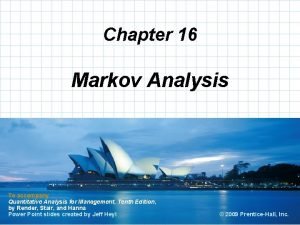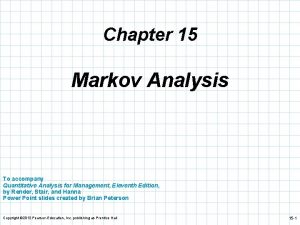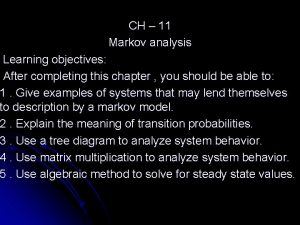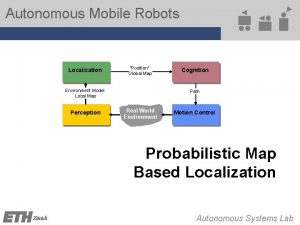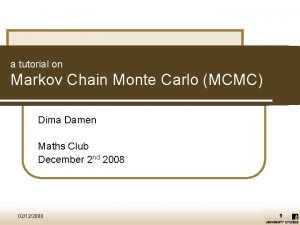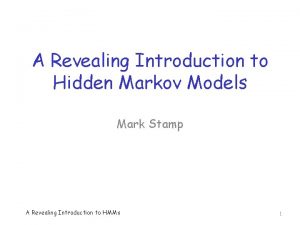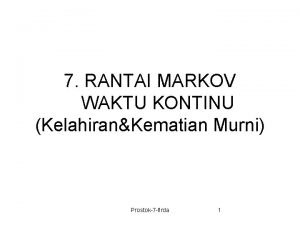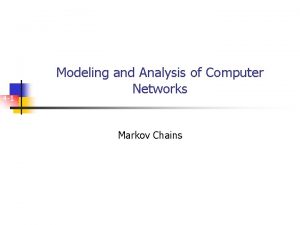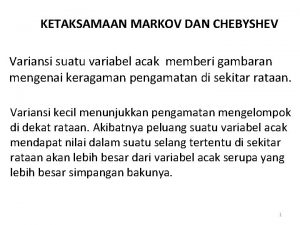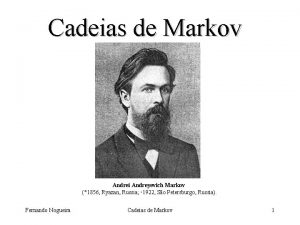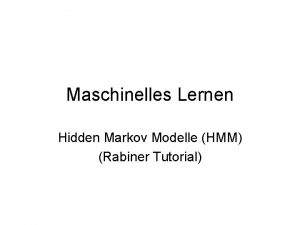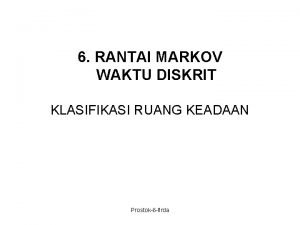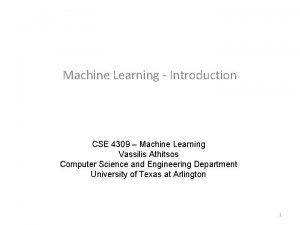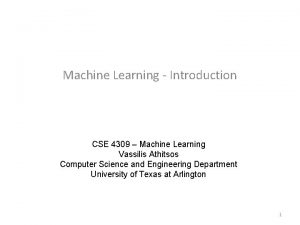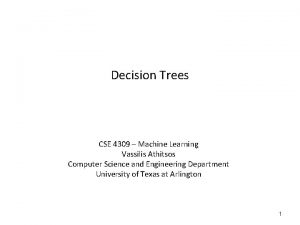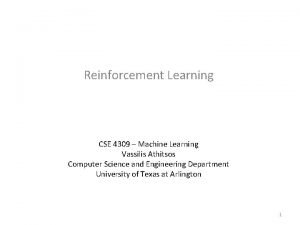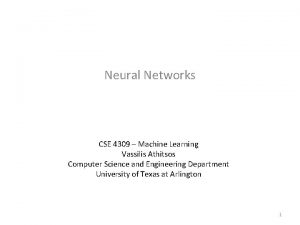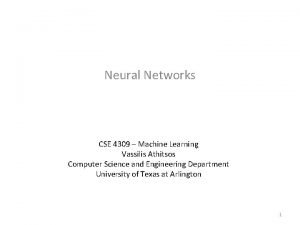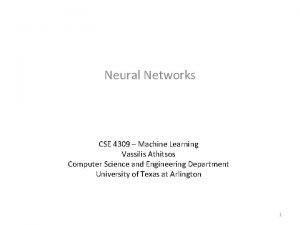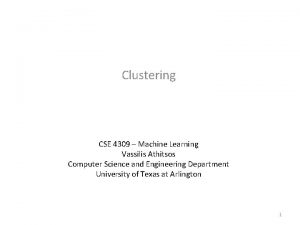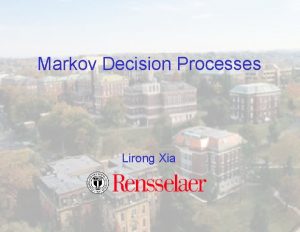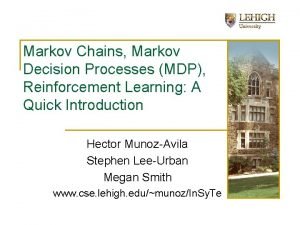Markov Decision Processes CSE 4309 Machine Learning Vassilis





























































































- Slides: 93

Markov Decision Processes CSE 4309 – Machine Learning Vassilis Athitsos Computer Science and Engineering Department University of Texas at Arlington 1

A Sequential Decision Problem 3 +1 2 -1 1 START 1 2 3 4 2

A Sequential Decision Problem 3 +1 2 -1 1 START 1 2 3 4 3

A Deterministic Case 3 +1 2 -1 1 START • Under some conditions, the solution for reward 1 maximization is easy to find. • Suppose that each action always succeeds: – – 2 3 4 The "go left" action takes you one position to the left. The "go right" action takes you one position to the right. The "go up" action takes you one position upwards. The "go down" action takes you one position downwards. • This situation is called deterministic. – A deterministic environment is an environment where the result of any action is known in advance. – A non-deterministic environment is an environment where the result of any action is not known in advance. 4

A Deterministic Case 3 +1 2 -1 1 START 1 2 3 4 5

A Deterministic Case 3 +1 2 -1 1 START 1 2 3 4 6

A Deterministic Case 3 +1 2 -1 1 START 1 2 3 4 7

A Deterministic Case 3 +1 2 -1 1 START 1 2 3 4 8

A Non. Deterministic Case • Under some conditions, life gets more complicated. • Suppose that each action: 3 +1 2 -1 1 START 1 2 3 4 – Succeeds with probability 0. 8. – Has a 0. 2 probability of moving to a direction that differs by 90 degrees from the intended direction. • For example: the "go up" action: – Has a probability of 0. 8 to take the agent one position upwards. – Has a probability of 0. 1 to take the agent one position to the left. – Has a probability of 0. 1 to take the agent one position to the right. 9

A Non. Deterministic Case 3 +1 2 -1 1 START 1 2 3 4 10

Sequential Decision Problems • Under some conditions, life gets more complicated. • Suppose that each action: 3 +1 2 -1 1 START 1 2 3 4 – Succeeds with probability 0. 8. – Has a 0. 2 probability of moving to a direction that differs by 90 degrees from the intended direction. • Suppose that bumping into the wall leads to not moving. • In that case, choosing the best action to take at each position is a more complicated problem. • A sequential decision problem consists of choosing the best sequence of actions, so as to maximize the total rewards. 11

Markov Decision Processes (MDPs) 3 +1 2 -1 1 START 1 2 3 4 12

A Transition Model Example • 3 +1 2 -1 1 START 1 2 3 4 13

A Transition Model Example • 3 +1 2 -1 1 START 1 2 3 4 14

A Transition Model Example • 3 +1 2 -1 1 START 1 2 3 4 15

A Transition Model Example • 3 +1 2 -1 1 START 1 2 3 4 16

A Transition Model Example • 3 +1 2 -1 1 START 1 2 3 4 17

A Transition Model Example • 3 +1 2 -1 1 START 1 2 3 4 18

A Transition Model Example • 3 +1 2 -1 1 START 1 2 3 4 19

A Transition Model Example • 3 +1 2 -1 1 START 1 2 3 4 20

A Transition Model Example • 3 +1 2 -1 1 START 1 2 3 4 21

Markov Decision Processes (MDPs) 3 +1 2 -1 1 START 1 2 3 4 22

Discounted Additive Rewards 3 +1 2 -1 1 START 1 2 3 4 23

Discounted Additive Rewards 3 +1 2 -1 1 START 1 2 3 4 24

Discounted Additive Rewards 3 +1 2 -1 1 START 1 2 3 4 25

Discounted Additive Rewards 3 +1 2 -1 1 START 1 2 3 4 26

Discounted Additive Rewards 3 +1 2 -1 1 START 1 2 3 4 27

The MDP Problem 3 +1 2 -1 1 START 1 2 3 4 28

Policy Examples 3 +1 2 -1 1 1 2 3 4 29

Policy Examples 3 +1 2 -1 1 1 2 3 4 30

Policy Examples 3 +1 2 -1 1 1 2 3 4 31

Utility of a State 3 +1 2 -1 1 START 1 2 3 4 32

A Note on Notation 3 +1 2 -1 1 START 1 2 3 4 33

Utility of a Sequence • 3 +1 2 -1 1 START 1 2 3 4 34

Utility of a Sequence • 3 +1 2 -1 1 START 1 2 3 4 35

Utility of a State • 2 +1 1 START 1 -1 2 36

Utility of a State • 2 +1 1 START 1 -1 2 37

Utility of a State • 2 +1 1 START 1 -1 2 38

Utility of a State • 2 +1 1 START 1 -1 2 39

Utility of a State • 2 +1 1 START 1 -1 2 40

Utility of a State • 2 +1 1 START 1 -1 2 41

Utility of a State • 2 +1 1 START 1 -1 2 42

Utility of a State • 2 +1 1 START 1 -1 2 43

Utility of a State • 2 +1 1 START 1 -1 2 44

Utility of a State • 2 +1 1 START 1 -1 2 45

Utility of a State • 2 +1 1 START 1 -1 2 46

Utility of a State • 2 +1 1 START 1 -1 2 47

Utility of a State • 2 +1 1 START 1 -1 2 48

Utility of a State • 2 +1 1 START 1 -1 2 49

Utility of a State • 2 +1 1 START 1 -1 2 50

Utility of a State • 2 +1 1 START 1 -1 2 51

Utility of a State +1 1 START • 2 1 -1 2 52

Utility of a State 2 +1 1 START 1 -1 2 • 53

Utility of a State 2 +1 1 START 1 -1 2 • 54

Utility of a State 2 +1 1 START 1 -1 2 • 55

The Bellman Equation 2 +1 1 START 1 -1 2 • Combining these equations together, we get: • This equation is called the Bellman equation. 56

The Bellman Equation 2 +1 1 START 1 -1 2 • 57

The Value Iteration Algorithm • 58

The Value Iteration Algorithm • 59

The Value Iteration Algorithm • We will skip the proof, but it can be proven that this algorithm converges to the correct solutions of the Bellman equations. – Details can be found in S. Russell and P. Norvig, "Artificial Intelligence: A Modern Approach", third edition (2009), Prentice Hall. 60

The Value Iteration Algorithm • 61

The Value Iteration Algorithm • So, the value iteration algorithm can be summarized as follows: – Initialize utilities of states to zero values. – Repeat updating utilities of states using Bellman updates, until the estimated values converge. 62

A Value Iteration Example • 3 +1 2 -1 1 START 1 2 3 4 3 0 0 2 0 0 0 1 2 3 4 Utility Values 63

A Value Iteration Example • 3 +1 2 -1 1 START 1 3 -0. 04 2 3 4 -0. 04 +1 -0. 04 2 3 4 2 -0. 04 1 Utility Values 64

A Value Iteration Example • 3 +1 2 -1 1 START 1 3 -0. 08 2 3 4 -0. 08 0. 67 +1 -0. 08 2 3 4 2 -0. 08 1 Utility Values 65

A Value Iteration Example • 3 +1 2 -1 1 START 1 3 -0. 11 2 3 4 0. 43 0. 73 +1 0. 35 -1 -0. 11 2 3 4 2 -0. 11 1 Utility Values 66

A Value Iteration Example • 3 +1 2 -1 1 START 3 1 2 3 4 0. 25 0. 57 0. 78 +1 0. 43 -1 -0. 14 0. 19 -0. 14 2 3 4 2 -0. 14 1 Utility Values 67

A Value Iteration Example • 3 +1 2 -1 1 START 1 2 3 4 3 0. 38 0. 62 0. 79 +1 2 0. 12 0. 47 -1 0. 07 0. 24 -0. 01 2 3 4 1 -0. 16 1 Utility Values 68

A Value Iteration Example • 3 +1 2 -1 1 START 1 2 3 4 3 0. 45 0. 64 0. 79 +1 2 0. 25 0. 48 -1 1 0. 04 0. 15 0. 30 0. 05 1 2 3 4 Utility Values 69

A Value Iteration Example • 3 +1 2 -1 1 START 1 2 3 4 3 0. 48 0. 65 0. 79 +1 2 0. 33 0. 48 -1 1 0. 16 0. 21 0. 32 0. 09 1 2 3 4 Utility Values 70

A Value Iteration Example • 3 +1 2 -1 1 START 1 2 3 4 3 0. 50 0. 65 0. 80 +1 2 0. 37 0. 49 -1 1 0. 23 0. 34 0. 11 1 2 3 4 Utility Values 71

A Value Iteration Example • 3 +1 2 -1 1 START 1 2 3 4 3 0. 51 0. 65 0. 80 +1 2 0. 40 0. 49 -1 1 0. 30 0. 25 0. 34 0. 13 1 2 3 4 Utility Values 72

Computing the Optimal Policy • 73

Computing the Optimal Policy • 3 +1 2 -1 1 1 2 3 4 Optimal Policy 3 0. 90 2 0. 87 1 0. 85 1 0. 93 0. 95 +1 0. 77 -1 0. 82 0. 79 0. 57 2 3 4 Utility Values 74

Computing the Optimal Policy • 3 +1 2 -1 1 1 2 3 4 Optimal Policy Probability Next State Utility 0. 8 (2, 3) 0. 77 0. 1 (3, 3) 0. 95 0. 1 (1, 3) 0. 79 3 0. 90 2 0. 87 1 0. 85 1 0. 93 0. 95 +1 0. 77 -1 0. 82 0. 79 0. 57 2 3 4 Utility Values 75

Computing the Optimal Policy • 3 +1 2 -1 1 1 2 3 4 Optimal Policy Probability Next State Utility 0. 8 (2, 3) -1 0. 1 (3, 3) 0. 95 0. 1 (1, 3) 0. 79 3 0. 90 2 0. 87 1 0. 85 1 0. 93 0. 95 +1 0. 77 -1 0. 82 0. 79 0. 57 2 3 4 Utility Values 76

Computing the Optimal Policy • 3 +1 2 -1 1 1 2 3 4 Optimal Policy Probability Next State Utility 0. 8 (3, 3) 0. 95 0. 1 (2, 4) -1. 00 0. 1 (2, 3) 0. 77 3 0. 90 2 0. 87 1 0. 85 1 0. 93 0. 95 +1 0. 77 -1 0. 82 0. 79 0. 57 2 3 4 Utility Values 77

Computing the Optimal Policy • 3 +1 2 -1 1 1 2 3 4 Optimal Policy Probability Next State Utility 0. 8 (1, 3) 0. 79 0. 1 (2, 4) -1. 00 0. 1 (2, 3) 0. 77 3 0. 90 2 0. 87 1 0. 85 1 0. 93 0. 95 +1 0. 77 -1 0. 82 0. 79 0. 57 2 3 4 Utility Values 78

Computing the Optimal Policy • 3 +1 2 -1 1 1 2 3 4 Optimal Policy 3 0. 90 2 0. 87 1 0. 85 1 0. 93 0. 95 +1 0. 77 -1 0. 82 0. 79 0. 57 2 3 4 Utility Values 79

Computing the Optimal Policy • 3 +1 2 -1 1 1 2 3 4 Optimal Policy 3 0. 90 2 0. 87 1 0. 85 1 0. 93 0. 95 +1 0. 77 -1 0. 82 0. 79 0. 57 2 3 4 Utility Values 80

The Policy Iteration Algorithm • 81

The Policy Iteration Algorithm • 82

The Policy Iteration Algorithm • To be able to implement the policy iteration algorithm, we need to specify how to carry out each of the two steps of the main loop: – Policy evaluation. – Policy improvement. 83

The Policy Evaluation Step • 84

The Policy Evaluation Step • 85

The Policy Evaluation Step • 86

The Policy Evaluation Step • 87

The Policy Iteration Algorithm • 88

The Policy Iteration Algorithm • The main loop alternates between: • Updating the utilities given the policy. • Updating the policy given the utilities. The main loop exits when the policy stops changing. 89

The Policy Iteration Algorithm • The main loop alternates between: • Updating the utilities given the policy. • Updating the policy given the utilities. The main loop exits when the policy stops changing. 90

The Policy Iteration Algorithm • The main loop alternates between: • Updating the utilities given the policy. • Updating the policy given the utilities. The main loop exits when the policy stops changing. 91

Markov Decision Processes: Recap • 92

Markov Decision Processes: Recap • The value iteration algorithm computes the utility of each state using an iterative approach. – Once the utilities of all states have been computed, the optimal policy is defined by identifying, for each state, the action leading to the highest expected utility. • The policy iteration algorithm is a more efficient alternative, at the cost of possibly losing some accuracy. – It computes the optimal policy directly, without computing exact values for the utilities. – Utility values are updated for a few rounds only, and not until convergence. 93
 Puterman markov decision processes
Puterman markov decision processes No decision snap decision responsible decision
No decision snap decision responsible decision Investment decision financing decision dividend decision
Investment decision financing decision dividend decision Markov decision
Markov decision Markov decision process merupakan tuple dari
Markov decision process merupakan tuple dari Markov decision
Markov decision Markov decision
Markov decision Markov decision
Markov decision Lee wee sun
Lee wee sun Tai sing lee
Tai sing lee Value iteration
Value iteration Vassilis athitsos
Vassilis athitsos Athitsos
Athitsos Vassilis christophides
Vassilis christophides Vassilis athitsos
Vassilis athitsos Vassilis athitsos
Vassilis athitsos Vassilis athitsos
Vassilis athitsos Vassilis athitsos
Vassilis athitsos Vassilis athitsos
Vassilis athitsos Fisher's
Fisher's Occam rasor
Occam rasor Concurrent processes are processes that
Concurrent processes are processes that Concept learning task in machine learning
Concept learning task in machine learning Analytical learning in machine learning
Analytical learning in machine learning Pac learning model in machine learning
Pac learning model in machine learning Pac learning model in machine learning
Pac learning model in machine learning Inductive and analytical learning in machine learning
Inductive and analytical learning in machine learning In analytical learning hypothesis fits
In analytical learning hypothesis fits Instance based learning in machine learning
Instance based learning in machine learning Inductive learning machine learning
Inductive learning machine learning First order rule learning in machine learning
First order rule learning in machine learning Remarks on lazy and eager learning
Remarks on lazy and eager learning Cmu machine learning
Cmu machine learning Wharton risk management
Wharton risk management Cuadro comparativo de e-learning
Cuadro comparativo de e-learning Decision tree and decision table
Decision tree and decision table Markov chain tutorial
Markov chain tutorial Markov chain absorbing state
Markov chain absorbing state Gauss markov assumptions
Gauss markov assumptions Model of hr forecasting
Model of hr forecasting Hidden markov chain
Hidden markov chain Aperiodic markov chain
Aperiodic markov chain Hidden markov model rock paper scissors
Hidden markov model rock paper scissors Gauss markov assumptions
Gauss markov assumptions Gauss markov theorem
Gauss markov theorem Bayes filter algorithm
Bayes filter algorithm Communicating classes markov chain
Communicating classes markov chain Markov chain nlp
Markov chain nlp Aperiodic markov chain
Aperiodic markov chain Hidden markov model tutorial
Hidden markov model tutorial Embedded markov chain
Embedded markov chain Markov random field
Markov random field Local markov assumption
Local markov assumption Markov model
Markov model Aperiodic markov chain
Aperiodic markov chain Markov analysis
Markov analysis Aperiodic markov chain
Aperiodic markov chain Jørn vatn
Jørn vatn Basic concepts of probability
Basic concepts of probability Ratio test rules
Ratio test rules Tracking cmsc
Tracking cmsc Markov localization
Markov localization Hidden markov chain
Hidden markov chain Bmics
Bmics Gene finding
Gene finding Markov analysis hr
Markov analysis hr Hidden markov chain
Hidden markov chain Hidden markov map matching through noise and sparseness
Hidden markov map matching through noise and sparseness Gauss markov varsayımları
Gauss markov varsayımları Aperiodic markov chain
Aperiodic markov chain Gauss markov assumptions
Gauss markov assumptions Aperiodic markov chain
Aperiodic markov chain Chebyshev inequality
Chebyshev inequality Markov inequality proof
Markov inequality proof Kiểm định sự phù hợp của mô hình hồi quy
Kiểm định sự phù hợp của mô hình hồi quy Properties of least square estimates
Properties of least square estimates Ppt
Ppt What is markov analysis
What is markov analysis Example of markov analysis
Example of markov analysis Cadenas
Cadenas Procesos de markov de primer orden
Procesos de markov de primer orden Markov localization
Markov localization Alimam
Alimam Markov chain monte carlo tutorial
Markov chain monte carlo tutorial A revealing introduction to hidden markov models
A revealing introduction to hidden markov models Rantai markov kontinu
Rantai markov kontinu Birth death process
Birth death process Operations research and supply chain
Operations research and supply chain Ketaksamaan chebyshev
Ketaksamaan chebyshev Andrei andreyevich markov
Andrei andreyevich markov Rabiner hmm
Rabiner hmm Contoh soal rantai markov waktu diskrit
Contoh soal rantai markov waktu diskrit A revealing introduction to hidden markov models
A revealing introduction to hidden markov models Markov
Markov



